You’ll want to get your bedroom motion detector placement right the first time, because improper positioning can turn your security system into a source of frustration rather than protection. The wrong spot means constant false alarms from normal movement, while poor coverage leaves vulnerable blind spots that defeat the entire purpose. Your bedroom’s unique layout, furniture arrangement, and daily routines all influence where these sensors will work most effectively.
How Motion Detectors Work in Bedroom Environments
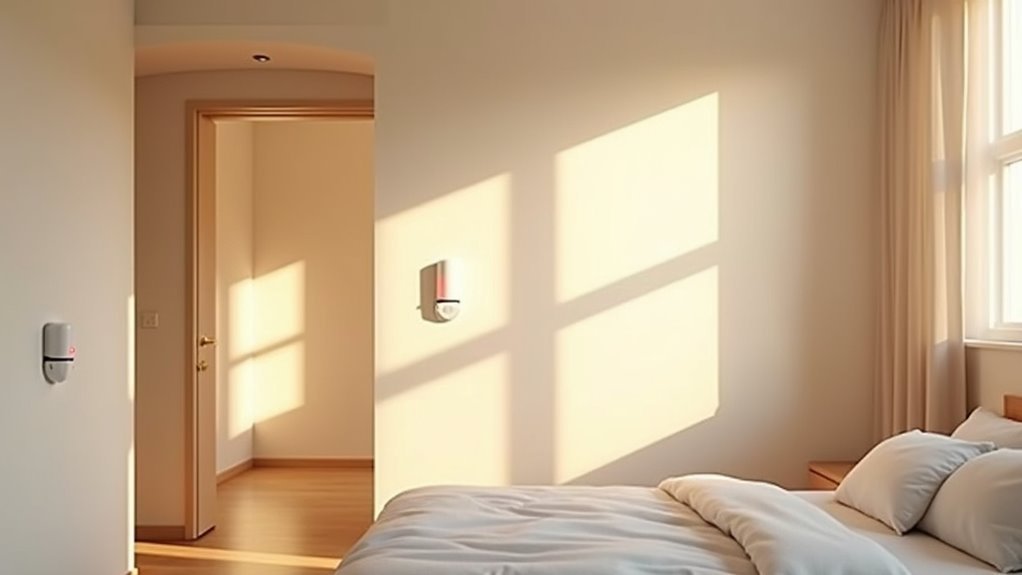
When you’re setting up motion detectors in your bedroom, understanding how these devices function in this unique environment is essential for ideal performance. Motion sensors use passive infrared technology to detect heat signatures from your body movements. These devices monitor temperature changes in their coverage area, triggering alerts when they sense variations that indicate human presence.
Your bedroom presents specific challenges that affect sensor functionality. Positioning sensors correctly becomes vital since you’ll experience extended periods of minimal movement during sleep.
Bedroom motion sensors require strategic placement to account for prolonged sleep periods with minimal body movement.
The technology works by comparing baseline room temperature against the heat your body radiates. However, electronic devices, radiators, and other heat sources can interfere with detection accuracy, creating false alarms.
Understanding these operational principles helps you make informed decisions about the best placement for reliable security coverage.
Optimal Height for Bedroom Motion Sensor Installation
Finding the right height for your bedroom motion sensor dramatically impacts its effectiveness and reduces unwanted alerts. The ideal height for installing motion sensors ranges between 6 to 8 feet, providing extensive room coverage while minimizing false triggers from pets.
Position your sensor at chest height to enhance detection capabilities, as this placement effectively captures horizontal movement across the sensor’s field of view rather than direct approaches.
Avoid mounting sensors too low, which increases false alarms from normal bedroom activities like rolling over in bed.
Corner installation at the proper height maximizes your detection angle and coverage area. Don’t place sensors directly across from your bed or near windows, as these locations create limited detection ranges and potential false alarms from external movements.
Strategic Corner Placement for Maximum Coverage
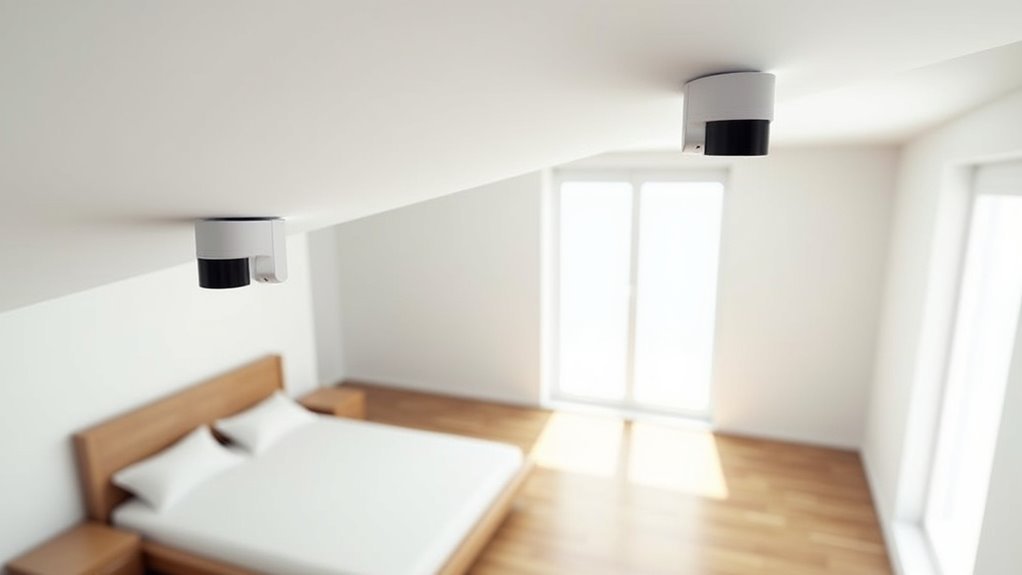
You’ll achieve maximum bedroom coverage by positioning your motion detectors in corners at the ideal 6-8 foot height range.
This strategic placement eliminates blind spots that typically occur with wall-mounted sensors while providing an extensive view of the entire room.
Corner installation also reduces false alarms from normal sleep movements since the sensors can distinguish between minor bed shifting and actual room entry.
Optimal Corner Height Placement
Although many homeowners place motion detectors randomly throughout their bedrooms, strategic corner positioning at 6 to 8 feet high delivers maximum coverage and detection accuracy. This ideal corner height placement guarantees your sensor’s field of view covers the entire room while minimizing false alarms from minor movements.
| Height Range | Coverage Area | Detection Quality |
|---|---|---|
| 4-6 feet | Limited scope | Frequent false alerts |
| 6-8 feet | Full room coverage | Ideal human detection |
| 8+ feet | Reduced sensitivity | Missed small movements |
When determining your placement height, you’ll want to avoid positioning sensors near heat sources like radiators or windows with direct sunlight. The 6-8 foot range allows the detector to distinguish between significant human infrared signatures and smaller environmental changes, guaranteeing reliable bedroom security monitoring.
Avoiding Bedroom Blind Spots
Why do most bedroom motion detectors fail to provide thorough security coverage?
They’re often placed without considering furniture positioning and room layout, creating dangerous blind spots that intruders can exploit.
You’ll eliminate these vulnerabilities by strategically positioning motion detectors in corners where they can’t be obstructed by beds, dressers, or wardrobes.
Corner placement provides the widest field of view while keeping sensors away from large furniture that blocks detection zones.
Focus your sensors toward entry points like doors and windows for immediate threat detection.
In larger bedrooms, you’ll need multiple detectors to guarantee extensive coverage of all areas.
Don’t place sensors behind furniture or near heating sources, as these locations create detection gaps and trigger false alarms that compromise your security system’s effectiveness.
Minimizing Sleep Movement Triggers
Strategic corner placement transforms your bedroom motion detection system from a sleep-disrupting nuisance into an effective security tool.
When you position motion sensors in bedroom corners, you’ll maximize coverage while avoiding detection of typical sleep movements like tossing and turning.
To minimize triggers and eliminate false alarms through proper bedroom placement:
- Install sensors 6-8 feet high in corners, directing them away from the bed to avoid detecting normal sleep movement.
- Choose dual-technology sensors combining PIR and microwave detection to reduce sensitivity to minor motions.
- Avoid placement near windows or heat sources that can cause interference and unnecessary nighttime alerts.
This strategic approach guarantees your security system protects without disturbing your rest.
Positioning Sensors Near Bedroom Entry Points
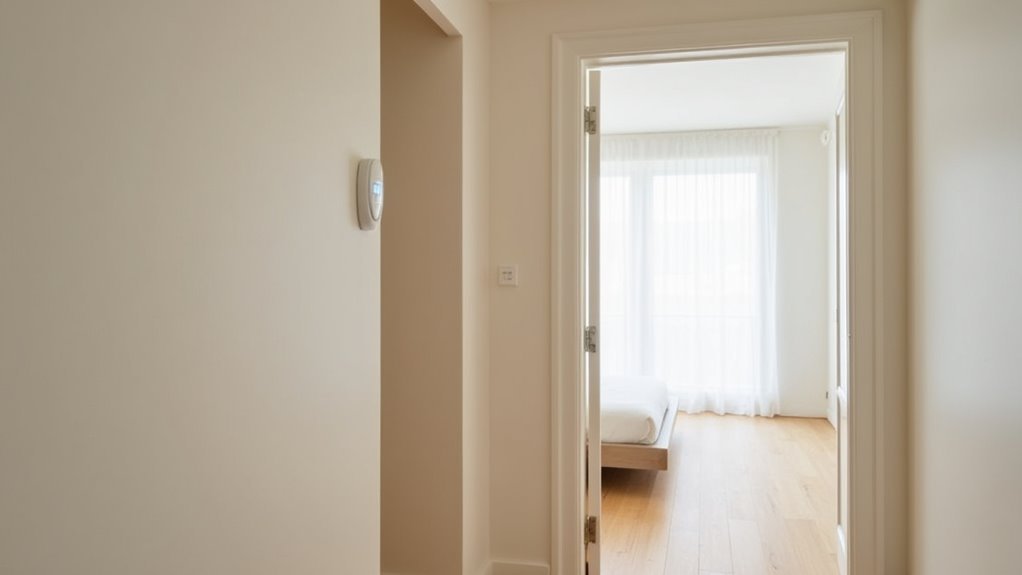
When positioning motion detectors near bedroom entry points, you’ll want to mount them on walls adjacent to doors rather than directly across from them. This placement guarantees sensors work effectively by detecting movement immediately when someone enters.
Install your motion detectors at 6 to 8 feet high for ideal coverage, preventing furniture from blocking their view.
Corner placement maximizes the field of view while minimizing blind spots near entrances. You’ll get better detection angles when sensors aren’t positioned directly opposite doorways, as this placement can limit effectiveness in confined bedroom spaces.
Adjust sensitivity settings carefully to prevent false alarms from normal sleep movements like rolling over. This strategic positioning around bedroom entry points creates a reliable security perimeter without disrupting your rest.
Avoiding False Alarms From Heat Sources
Heat sources can wreak havoc on your motion detector’s accuracy, causing frustrating false alarms that’ll disrupt your sleep and compromise security effectiveness.
Motion sensors rely on detecting temperature changes, making them vulnerable to interference from various heat-emitting sources in your bedroom.
To maintain ideal detection accuracy, follow these essential placement guidelines:
- Keep sensors 3+ feet away from heating vents – Air currents carrying warm air can trigger unwanted activations.
- Avoid positioning near radiators, space heaters, or electronics – These appliances create temperature fluctuations that confuse motion sensors.
- Stay clear of windows with direct sunlight exposure – Solar heat can alter the sensor’s environment throughout the day.
Consider upgrading to dual technology sensors combining PIR and microwave detection to minimize heat-related false alarms while maintaining reliable security coverage.
Managing Pet-Triggered Activations in Bedrooms
You’ll want to adjust your motion detector’s sensitivity settings to prevent your furry friends from constantly triggering false alarms throughout the night.
Installing sensors at a height of 6 to 8 feet considerably reduces the chance that smaller pets will activate the device while moving around your bedroom.
This strategic positioning allows the detector to focus on human-sized movements while ignoring most pet activity below its detection zone.
Pet-Resistant Sensor Settings
Pet owners face a common challenge with bedroom motion detectors: distinguishing between legitimate security threats and their four-legged companions’ nighttime wanderings.
Pet-resistant models solve this dilemma by intelligently differentiating between human movement and smaller animals, dramatically reducing unnecessary activations.
Configure your sensor sensitivity settings using these three key strategies:
- Height positioning – Mount sensors 6-8 feet high to minimize pet detection while maintaining optimal human movement coverage.
- Detection range adjustment – Customize sensitivity levels to exclude smaller pets while capturing human-sized threats effectively.
- Strategic placement – Avoid installing sensors near pet sleeping areas or frequently traveled pathways.
You’ll need to regularly test these pet-resistant settings to verify they’re working correctly.
Monitor performance closely during the first few weeks, making adjustments as needed to achieve the best balance between security and convenience.
Strategic Height Placement
While proper sensor configuration sets the foundation for pet-resistant detection, strategic height placement becomes your most powerful tool for eliminating false activations. Mount your motion sensor near ceiling level at 6 to 8 feet high to create an ideal detection zone that monitors human movement while reducing pet interference.
| Height Range | Pet Size | Detection Effectiveness | False Alarm Risk |
|---|---|---|---|
| 6-7 feet | Small pets | Excellent human coverage | Minimal risk |
| 7-8 feet | Medium pets | ideal performance | Very low risk |
| 8+ feet | Large pets | Good coverage | Low risk |
| Below 6 feet | All pets | Poor placement | High risk |
Strategic height placement helps minimize sensitivity to pets moving below the detector’s primary field of view. Position sensors in room corners to maximize coverage while maintaining this essential elevation advantage.
Sensor Placement Around Windows and Balcony Doors
Since windows and balcony doors represent the most common entry points for intruders, you’ll want to position your motion detectors strategically around these vulnerable areas.
Proper sensor placement around windows and doors guarantees thorough coverage while maintaining reliable movement detection technology that detects motion accurately.
Follow these essential guidelines for ideal placement:
- Mount sensors 6-8 feet high near windows and balcony doors, ensuring they’re unobstructed by curtains or furniture to maintain clear sight lines.
- Choose dual-technology sensors that combine passive infrared and microwave detection to minimize false alarms from pets or environmental changes.
- Position detectors in room corners facing balcony doors rather than directly in front of sunlit windows to avoid temperature-related false triggers.
This strategic approach maximizes detection effectiveness while reducing unwanted alerts.
Creating Detection Zones Without Privacy Invasion
You’ll need to balance effective security monitoring with respect for personal privacy when setting up motion detectors in your bedroom.
Strategic sensor positioning focuses on placing devices where they can detect intrusions without monitoring intimate areas like your bed or dressing spaces.
Privacy-first detection settings allow you to customize sensitivity levels and detection zones, ensuring you’re alerted to genuine security threats while maintaining your personal sanctuary.
Strategic Sensor Positioning
When positioning motion detectors in your bedroom, the corner placement at 6 to 8 feet high offers ideal coverage while respecting your personal space.
Strategic sensor positioning focuses on entry points rather than sleeping areas to prevent privacy invasion while maintaining effective security.
Optimal placement strategies include:
- Entry-focused positioning – Direct sensors toward doorways to create detection zones that activate when someone enters, keeping the bed area private.
- Furniture utilization – Use dressers and wardrobes to strategically block the sensor’s view of your bed while maintaining room coverage.
- Window avoidance – Keep sensors away from windows to prevent false alarms from external movement or light interference.
Consider dual-technology sensors combining PIR and microwave motion detection technology to enhance accuracy.
This approach guarantees you’ll detect intruders without compromising your intimate space.
Privacy-First Detection Settings
While modern motion detectors offer sophisticated security capabilities, you can configure privacy-first detection settings that create precise monitoring zones without compromising your personal space.
Focus your motion sensors exclusively on entry points rather than personal areas like your bed or dressing spaces. Use cylindrical tubes or physical barriers to narrow the detection field, ensuring sensors only activate when someone crosses designated thresholds.
Dual technology sensors combining infrared and microwave detection provide accurate monitoring while reducing false alarms from routine bedroom movements.
Mount sensors 6-8 feet high on walls adjacent to doorways for ideal entry point coverage. Configure sensitivity settings to detect actual intrusions without triggering from normal sleep movements.
Regularly test and adjust these privacy-focused detection zones to maintain effective security while preserving your personal sanctuary’s intimate atmosphere.
Furniture Considerations and Blind Spot Prevention
Strategic furniture placement plays a crucial role in ensuring your motion detectors function at peak efficiency. Large furniture pieces create significant blind spots that prevent sensors from detecting movement, functioning like shadows in your detection coverage.
Position your detectors in bedroom corners to maximize their field of view while minimizing furniture obstructions.
Follow these essential placement guidelines:
- Mount sensors 6-8 feet high to avoid low-profile furniture like beds and nightstands blocking detection paths.
- Maintain clear sightlines between detectors and key areas where movement occurs.
- Use decorative elements strategically like plants or lamps to camouflage sensors without compromising functionality.
You’ll achieve ideal coverage by keeping furniture away from direct sensor paths while ensuring detectors can monitor the entire room effectively.
Sensitivity Settings for Bedroom Motion Detectors
You’ll need to fine-tune your motion detector’s sensitivity settings to prevent false alarms from normal sleep movements like rolling over or shifting positions.
If you have pets in your bedroom, adjust the pet detection feature to distinguish between your furry friends and actual intruders.
Proper sensitivity calibration guarantees your detector won’t wake you with unnecessary alerts while maintaining effective security coverage.
Adjusting Pet Detection Settings
When pets share your bedroom space, fine-tuning your motion detector’s sensitivity settings becomes crucial for maintaining effective security without constant false alarms. Small movements like pets rolling over in bed can trigger sensors, disrupting your sleep and reducing system reliability.
To optimize pet detection settings:
- Mount sensors 6-8 feet high to focus detection on human-level movement while reducing pet interference.
- Install dual technology sensors that combine PIR and microwave technology for enhanced discrimination between human and pet movements.
- Position detectors away from pet activity zones like beds or favorite sleeping spots where animals frequently move.
Regular testing guarantees your adjusting sensitivity settings effectively distinguish between threats and harmless pet activity.
Experiment with different configurations to minimize false alarms while maintaining security coverage.
Sleep Movement Considerations
Bedroom motion detectors require careful sensitivity calibration to distinguish between genuine security threats and normal sleep movements that occur throughout the night.
When configuring sleep movement considerations, you’ll need to fine-tune sensitivity settings to prevent false alarms from rolling over, tossing, or shifting positions while sleeping. Start by mounting sensors 6 to 8 feet high to minimize detection of minor movements below.
Test your detector’s responsiveness during typical nighttime activities to establish ideal sensitivity levels.
Consider installing dual technology sensors that combine passive infrared and microwave technology for superior accuracy in distinguishing between actual intruders and natural sleep movements. These advanced sensors considerably reduce nuisance alerts while maintaining effective security coverage.
Regularly evaluate and adjust your settings based on sleep patterns and bedroom layout changes to guarantee consistent performance.
False Alarm Prevention
Since false alarms can disrupt your sleep and compromise your security system’s effectiveness, proper sensitivity calibration becomes essential for bedroom motion detectors.
You’ll need to fine-tune these settings to distinguish between genuine security threats and normal sleep movements like tossing and turning.
Here’s how to prevent false alarms:
- Adjust sensitivity settings to reduce triggers from minor movements such as shifting in bed while maintaining detection of actual intruders.
- Position detectors 6-8 feet high to better differentiate between human movement and pets that might wander through your bedroom.
- Use dual technology sensors combining passive infrared and microwave detection for more accurate threat identification.
Experiment with placement to cover high-traffic areas without furniture obstructions, and regularly monitor performance to optimize your detector’s functionality.
Multiple Sensor Configurations for Large Bedrooms
Large bedrooms present unique challenges that a single motion detector simply can’t handle effectively. You’ll need multiple sensors strategically positioned in opposite corners to achieve ideal detection throughout the space.
Install each sensor at 6 to 8 feet high to maximize their field of view while preventing false triggers from pets or minor movements.
Consider dual-technology sensors combining PIR and microwave technology for enhanced accuracy in areas with varying activity levels. Test different placements to eliminate blind spots, ensuring furniture or decor won’t obstruct detection paths.
Create separate zones using multiple sensors for zone activation capabilities. This allows you to customize lighting and security responses based on specific bedroom areas, giving you greater control over your large bedroom’s monitoring system.
Integration With Bedroom Lighting Systems
Three key advantages emerge when you integrate motion detectors with your bedroom lighting system: enhanced convenience, improved energy efficiency, and seamless automation that adapts to your daily routines.
Position your motion sensors at 6 to 8 feet high for ideal room coverage while preventing false triggers from pets. Smart lighting systems connected to these detectors let you customize settings based on occupancy and time of day.
For maximum effectiveness, consider these integration strategies:
- Program time-specific activation – Set your automated lighting to activate only during designated hours for seamless nighttime routines.
- Combine with dimmable LEDs – Create soft illumination that won’t jar you awake during nighttime entries.
- Utilize smart connectivity – Connect your lighting systems to apps for personalized brightness and color temperature control.
Master Bedroom Vs Guest Room Placement Strategies
While your master bedroom requires different motion detector considerations than your guest room, both spaces demand strategic placement to balance security effectiveness with occupant comfort.
In your master bedroom, position motion sensors in corners near entrances and windows at 6-8 feet height for ideal coverage without furniture obstruction. Larger master bedrooms benefit from multiple sensors covering different zones effectively.
For guest room placement strategies, install motion sensors on walls opposite the bed to detect movement toward doors while minimizing false alarms from minor sleeping movements like rolling over. Smaller guest rooms typically need only one strategically placed sensor.
Avoid positioning sensors directly above beds in either room, and keep them away from heat sources like radiators or direct sunlight to prevent temperature-triggered false alarms.
Testing and Adjusting Detector Performance
Test your motion detectors systematically after installation to verify they’re performing at their peak effectiveness. Position detectors between 6 to 8 feet high to enhance detection while reducing false alarms from minor movements. Document performance during different bedroom activities like sleeping or reading to understand responsiveness patterns.
Follow this testing approach:
- Monitor false trigger frequency – Track when unnecessary activations occur to identify if sensitivity or placement adjustments are needed.
- Test field of view coverage – Verify high-traffic areas are covered without furniture or wall interference.
- Adjust sensitivity settings – Fine-tune responsiveness based on your bedroom’s specific layout and usage patterns.
Regular performance evaluation helps you optimize detector functionality. Make incremental adjustments rather than dramatic changes, and allow time between modifications to assess their impact on overall system reliability.
Frequently Asked Questions
Where Is Motion Detected in a Bedroom?
You’ll detect motion throughout your bedroom’s entire space when you position sensors in corners at 6-8 feet high. They’ll monitor movement near doorways, around furniture, and across open areas effectively.
Where Should You Not Place a Motion Sensor?
You shouldn’t place motion sensors behind large furniture, near heat sources like radiators, in non-climate-controlled areas, directly across from doors, or where pets frequently pass through spaces.
Where to Install Motion Sensors?
You should install motion sensors in room corners at 6-8 feet height for ideal coverage. Position them near doorways and entry points while avoiding areas directly above beds to prevent false alarms from sleep movements.
Where Is the Best Place to Put Sensors?
You’ll get ideal results placing sensors in room corners at 6-8 feet height, near entry points like doors. Don’t install them directly above beds, and guarantee they’re not blocked by furniture or curtains.

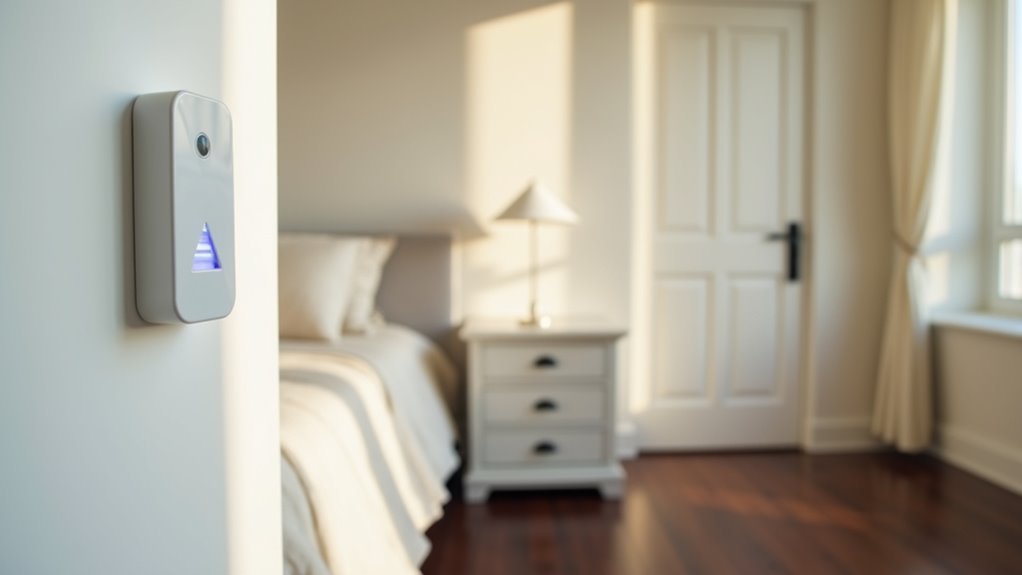
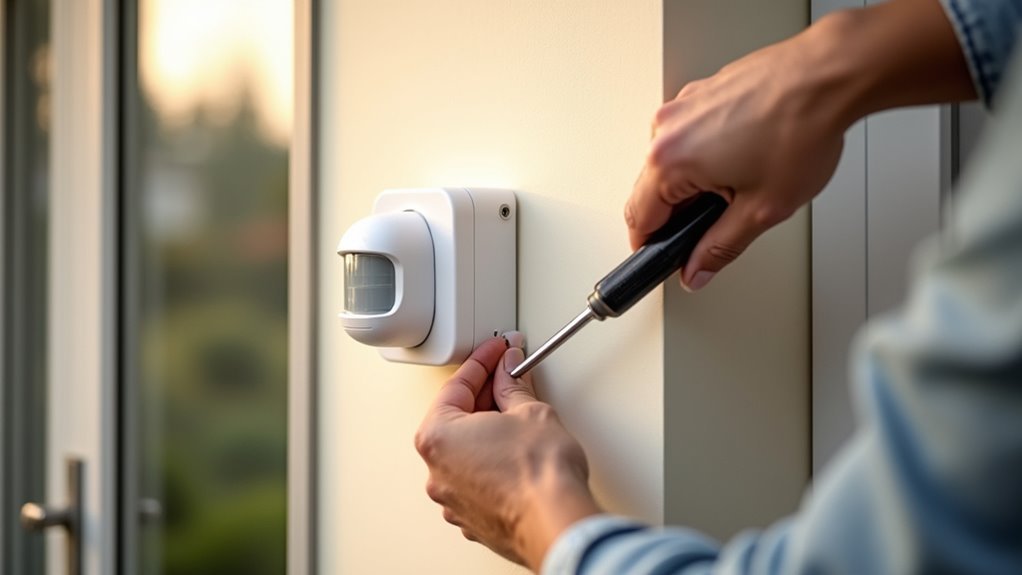
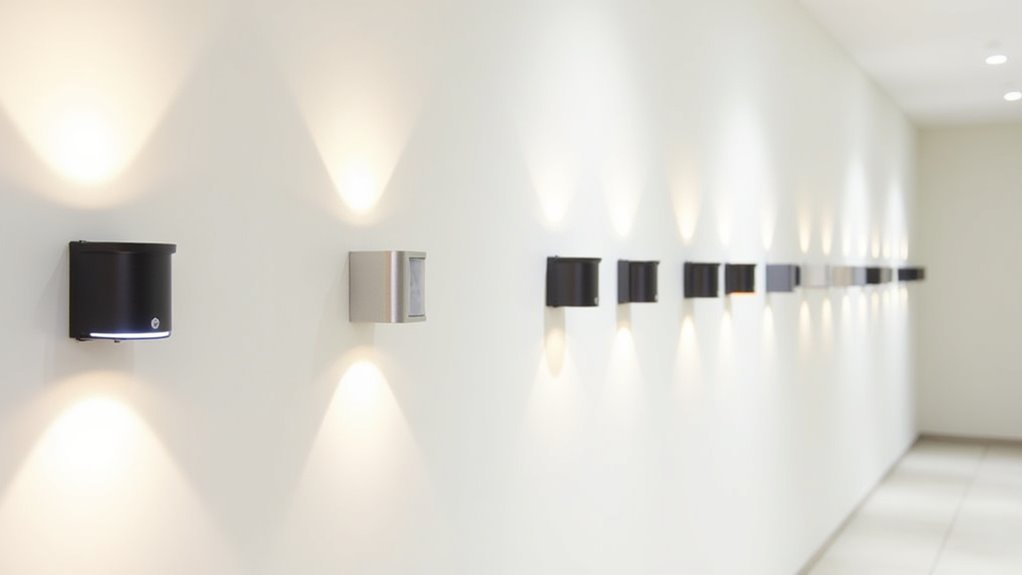
Leave a Reply